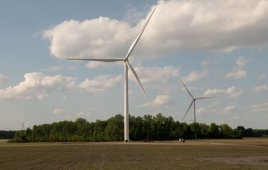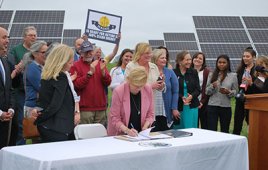
ElecTrak Pro actuators feature a compact design and short retracted length, coupled with a lightweight and high strength IP66 housing. IP67 protection is an option.
A line of linear actuators are electromechanical devices that install quickly and easily, and provide good accuracy, repeatability, reliability, and advanced control over critical machine operations. Unlike hydraulic and pneumatic alternatives, the ElecTrak Pro Series, from Thomson, Wood Dale, Ill, tune quickly and require no ongoing maintenance over the life of the equipment.
The units come in ball-screw configurations with maximum thrust to 2,000 lbs. and acme lead-screw configurations with a thrust rating of 750 lb. When standard models from the line don’t fit, ElecTrak Pro series actuators can be cost-effectively customized and configured. A few possible wind applications include opening and closing f nacelle hatches, and activating locking brakes on turbine rotors. The design is also well suited for use in tough, space restricted vehicles.
A built-in microprocessor provides Electronic Load Monitoring (ELM) to ensure long actuator life and maximum reliability even in harsh conditions. ELM continuously monitors critical parameters and acts as an electronic clutch, stopping the actuator at end of stroke and mid-stroke overload. ELM also provides dynamic braking for consistent, repeatable stops, and holds the load with power off. The microprocessor also includes a Signal Follower feature that can receive a signal from a remote potentiometer, or be used to synchronize multiple actuators.
Control options include programmable limit switches that let users teach and repeat end-of-stroke positions, low-level switching for direct control from a PC or PLC, and end-of-stroke indications. Optional feedback is either a quadrature Hall effect digital output or analog output by a linear potentiometer.
A low-voltage power switching option allows directly connecting the actuator with programmable controllers without the risk of overloading sensitive, low-voltage components. The option also lets low-cost switches control the actuator rather than heavy relays, and permits a smaller wire cross section for the control circuits.
A cover tube and extension tube are both stainless steel for corrosion resistance, and an integral nut support guide increases the allowed static column loading by 20% compared with traditional nut-and-screw designs for a stronger, safer, and more durable machine. Electrical connections are built into the die-cast aluminum housing.
Filed Under: Uncategorized





Dear Sir..
we required the Actuator with the following specifications:
12 Volt DC
Stroke 2″
Length (Closed/Extended): 6¼” – 8 ¼”
Speed/Second: 1/2
Load/Lbs:110
Regards
M.Sajjad
GRP Engineers & Consultants